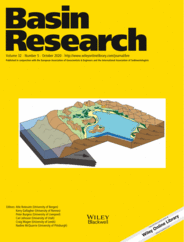
Full text loading...
 , Abdalla Y. Mohamed1, Ayad N. F. Edilbi1
, Abdalla Y. Mohamed1, Ayad N. F. Edilbi1 , Yu‐Shih Lin2, Yuki Morono3,4, Kai‐Uwe Hinrichs5, Fumio Inagaki3,4,6
, Yu‐Shih Lin2, Yuki Morono3,4, Kai‐Uwe Hinrichs5, Fumio Inagaki3,4,6
Basin models can simulate geological, geochemical and geophysical processes and potentially also the deep biosphere, starting from a burial curve, assuming a thermal history and utilizing other experimentally obtained data. Here, we apply basin modelling techniques to model cell abundances within the deep coalbed biosphere off Shimokita Peninsula, Japan, drilled during Integrated Ocean Drilling Program Expedition 337. Two approaches were used to simulate the deep coalbed biosphere: (a) In the first approach, the deep biosphere was modelled using a material balance approach that treats the deep biosphere as a carbon reservoir, in which fluxes are governed by temperature‐controlled metabolic processes that retain carbon via cell‐growth and cell‐repair and pass it back via cell‐damaging reactions. (b) In the second approach, the deep biosphere was modelled as a microbial community with a temperature‐controlled growth ratio and carrying capacity (a limit on the size of the deep biosphere) modulated by diagenetic‐processes. In all cases, the biosphere in the coalbeds and adjacent habitat are best modelled as a carbon‐limited community undergoing starvation because labile sedimentary organic matter is no longer present and petroleum generation is yet to occur. This state of starvation was represented by the conversion of organic carbon to authigenic carbonate and the formation of kerogen. The potential for the biosphere to be stimulated by the generation of carbon‐dioxide from the coal during its transition from brown to sub‐bituminous coal was evaluated and a net thickness of 20 m of lignite was found sufficient to support an order of magnitude greater number of cells within a low‐total organic carbon (TOC) horizon. By comparison, the stimulation of microbial populations in a coalbed or high‐TOC horizon would be harder to detect because the increase in population size would be proportionally very small.
,Using geological information and a basin modelling approach the deep biosphere of the Shimokita coalbeds has been modelled over deep geological time. This required coupling metabolic and geochemical processes to far field geological and tectonic events. Viewed in this light sedimentary basins become living breathing entities that operate on geological time scales.

Article metrics loading...

Full text loading...
References


Data & Media loading...

